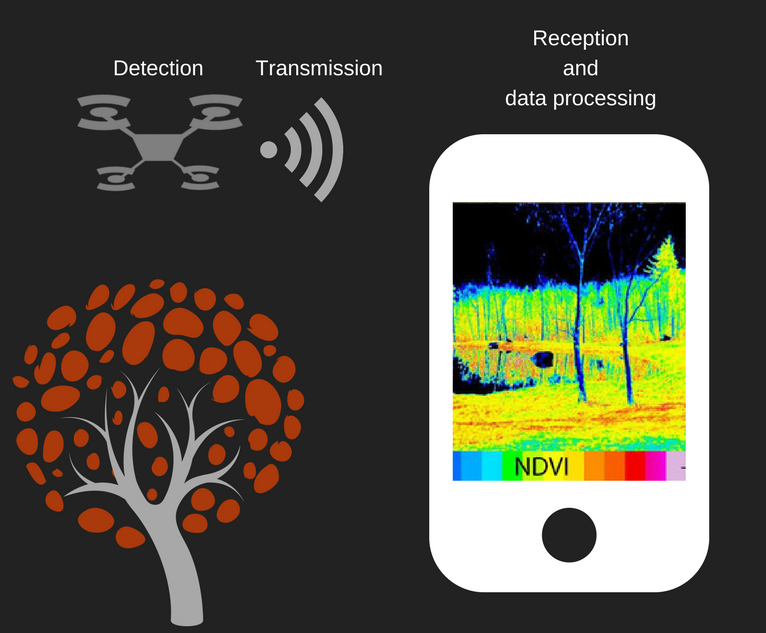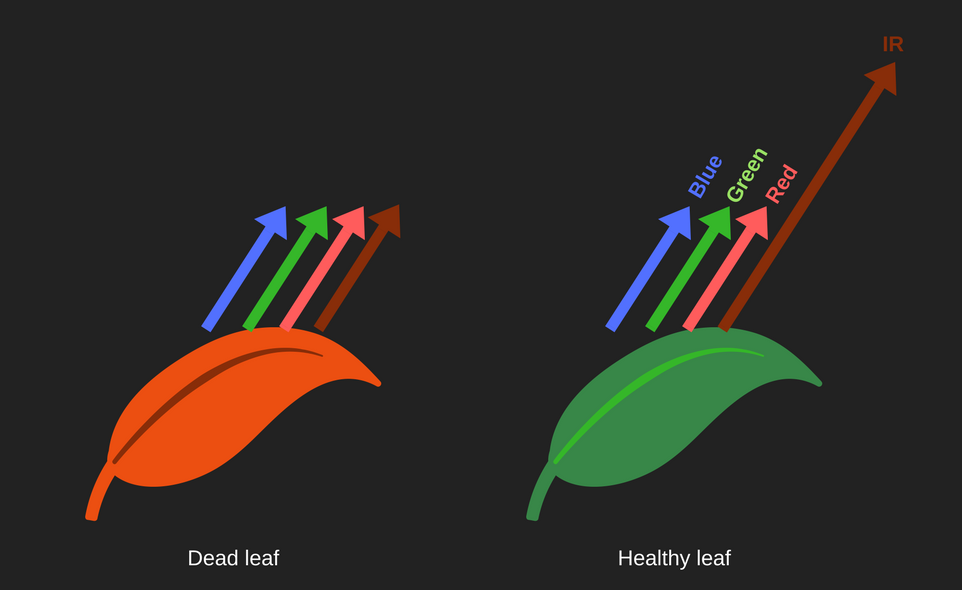| Line 1: | Line 1: | ||
{{Aix-Marseille|title=Detection of the disease|toc=__TOC__}} | {{Aix-Marseille|title=Detection of the disease|toc=__TOC__}} | ||
| − | |||
| − | |||
[[File:T--Aix-Marseille--transmission chain-1.png|right|400px|The hydric stress detection method.]] | [[File:T--Aix-Marseille--transmission chain-1.png|right|400px|The hydric stress detection method.]] | ||
| + | |||
| + | '''KILL XYL''' not only aim to cure the disease caused by [[Team:Aix-Marseille/Xylella_fastidiosa|''Xylella fastidiosa'']], but also to detect it. Nowadays, the most effective way to detect the bacterium is a method called PCR (Polymerase Chain Reaction) that can detect the presence of [[Team:Aix-Marseille/Xylella_fastidiosa|''Xylella fastidiosa'']]. However, this method is complex and requires DNA samples from each tree, which will undergo various treatments in the laboratory. | ||
Therefore, we focuse on another method which will allow us to work more easily with hundred of acres of crops. Thus, we though about the detection the first symptoms of disease : the hydric stress. The most revelant way to mesure the hydric stress is with the detection of leaf dryness. | Therefore, we focuse on another method which will allow us to work more easily with hundred of acres of crops. Thus, we though about the detection the first symptoms of disease : the hydric stress. The most revelant way to mesure the hydric stress is with the detection of leaf dryness. | ||
| − | [[File:T--Aix-Marseille--refraction spectrum leaves-1.png| | + | [[File:T--Aix-Marseille--refraction spectrum leaves-1.png|400px|right]] |
Olive trees are evergreen which means that leaves will not dry naturally. However, dry leaves can be a consequence of other factors than the disease caused[[Team:Aix-Marseille/Xylella_fastidiosa|''X. fastidiosa'']]. Thus our solution serves primarily as a warning device, it's appropriate to the detection of hydric stress through crops. If any is detected, you may take samples and ensure the presence [[Team:Aix-Marseille/Xylella_fastidiosa|''X. fastidiosa'']]. | Olive trees are evergreen which means that leaves will not dry naturally. However, dry leaves can be a consequence of other factors than the disease caused[[Team:Aix-Marseille/Xylella_fastidiosa|''X. fastidiosa'']]. Thus our solution serves primarily as a warning device, it's appropriate to the detection of hydric stress through crops. If any is detected, you may take samples and ensure the presence [[Team:Aix-Marseille/Xylella_fastidiosa|''X. fastidiosa'']]. | ||
Revision as of 18:15, 12 October 2017
Detection of the disease
Contents
KILL XYL not only aim to cure the disease caused by Xylella fastidiosa, but also to detect it. Nowadays, the most effective way to detect the bacterium is a method called PCR (Polymerase Chain Reaction) that can detect the presence of Xylella fastidiosa. However, this method is complex and requires DNA samples from each tree, which will undergo various treatments in the laboratory.
Therefore, we focuse on another method which will allow us to work more easily with hundred of acres of crops. Thus, we though about the detection the first symptoms of disease : the hydric stress. The most revelant way to mesure the hydric stress is with the detection of leaf dryness.
Olive trees are evergreen which means that leaves will not dry naturally. However, dry leaves can be a consequence of other factors than the disease causedX. fastidiosa. Thus our solution serves primarily as a warning device, it's appropriate to the detection of hydric stress through crops. If any is detected, you may take samples and ensure the presence X. fastidiosa.
AS healthy leaves return more infrared light than dry leaf we can calculate the Normalized Difference Vegetation Index (NDVI), which allows to determine the relative level of photosynthesis of a plant. NDVI is calculated by : $$\text{NDVI} = \frac{\text{NIR}-\text{RED}}{\text{NIR}+\text{RED}}$$
The calculated index is between -1 and 1 and is associated with a color scale that allows you to observe easily and quickly if the tree is healthy or not.
Sensor Operation
We use a Raspberry Pi 2 which will support the different software and programs used, a Black Pi camera (an infrared camera) and a ROSCO # 2007 blue filter, which is used for the detection of the drying of the tree.
Pi camera
Above, the black Pi camera used is shown on the left, and on the right the operation of a normal camera. Compared to a normal camera, an infrared camera doesn't have the anti-infrared filter.
However, we add another filter in front of the camera that will be used to create the NDVI image.
Blue filter ROSCO#2007
This filter is used to filter the light and keep only blue and near infrared wavelengths (see graph below), which is relevant for photosynthesis.
Software presentation
Presentation of Python and OpenCV
To make a NDVI image, we will use a library that allows image processing. This library allows the detection of objects, faces, shapes. It can be used with various programming languages, mainly C ++ and python. It is the last one that we have used for its portability, which will simplify the development.
Development of the NDVI image
In the computer memory, the images are coded in RGB, i.e. each color, red, green and blue, is coded on 1 byte and represents the intensity of the color. In a normal camera, the colors are captured and restored, the resulting image is in accordance with natural colors. In our case, the filter removes the red component, and is replaced by infrared. The resulting image of this montage is in "false colors" because it is composed of green and blue, visible by a human eye with infrared which is normally impossible to see.
The NDVI index can be calculated for each pixel of the image. For each pixel of the image we calculate the index NDVI with the relation shown previously:
$$\text{Index NDVI} = \frac{\text{NIR}-\text{RED}}{\text{NIR}+\text{RED}}$$
With the index of each pixel, we create a new grayscale image. The image is the visual representation of the NDVI index. However, the human eye cannot easily discern the gray levels, but more easily the color variations. We will use the OpenCV library to apply a color scale to our image. We apply the color colormap_jet.










